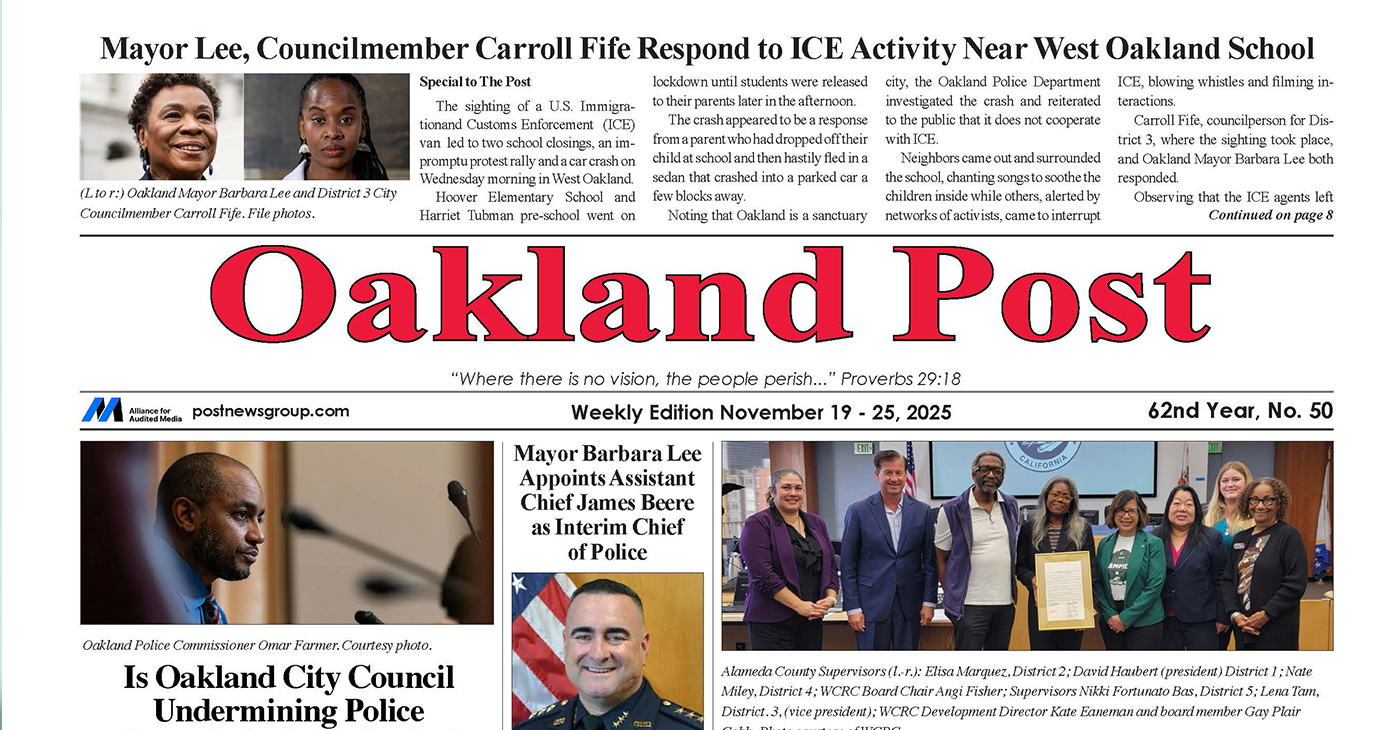Bay Area
‘Ms. Martha’ Humphrey is Oakland’s 2024 Mother of the Year
Oakland Parks, Recreation & Youth Development (OPRYD) honored Martha Humphrey as Oakland’s 2024 Mother of the Year. Affectionately known as “Ms. Martha,” Humphrey was recognized during the 71st Oakland Mother of the Year Award Ceremony held at Morcom Rose Garden, May 11. Nestled in an Oakland hillside above Lake Merritt, the garden event was hosted beneath a white tent beside a reflection pool surrounded by fragrant flowers and greenery. Councilmember Nikki Fortunato-Bas, District 2, provided the welcome and 2005 Mother of the Year Naomi Schiff served as mistress of ceremonies.

By Carla Thomas
Oakland Parks, Recreation & Youth Development (OPRYD) honored Martha Humphrey as Oakland’s 2024 Mother of the Year.
Affectionately known as “Ms. Martha,” Humphrey was recognized during the 71st Oakland Mother of the Year Award Ceremony held at Morcom Rose Garden, May 11. Nestled in an Oakland hillside above Lake Merritt, the garden event was hosted beneath a white tent beside a reflection pool surrounded by fragrant flowers and greenery.
Councilmember Nikki Fortunato-Bas, District 2, provided the welcome and 2005 Mother of the Year Naomi Schiff served as mistress of ceremonies.
Oakland Deputy Mayor Dr. Kimberly Mayfield-Lynch and Councilperson Carroll Fife, District 3, commended Humphrey for her impact on the community and her various accomplishments.
“So often the sacrifices that our elders make go unacknowledged and I think that it is so fitting to be at the Rose Garden to give roses to Ms. Martha while she is still here,” said Fife.
Humphrey is an inspiration who provided family and structure to so many foster youths, Fife added.
“Ms. Martha giving that to so many children is like planting seeds that will last forever. We are so grateful for you. We love you and we appreciate you. Happy Mother’s Day,” said Councilmember Dan Kalb, District 1, who presented Humphrey with roses.
Marilyn Reynolds of the City of Oakland Head Start program said, “It’s wonderful to see her recognized.”
OPRYD Special Events Coordinator and organizer Zermaine Thomas ensured the program ran smoothly and was excited to congratulate Humphrey and provide closing remarks.
Dressed in a royal blue satin suit with a matching hat accented with rhinestones, Humphrey was elated to be the lady of honor flanked by family members, foster children, government officials, and members of the community.
“I’m grateful to God,” she said as attendees took photographs with her.
Humphrey began caring for children at 8 years old, starting with her youngest sibling. At an early age, Humphrey decided that caring for children delighted her. When she reached adulthood, she began housekeeping, which would often include caring for her employer’s children. She accepted a job as a nanny caring for the four children of a lawyer and his wife at their home in Houston, Texas. When the family relocated to San Francisco in March of 1950, Humphrey came with them to assist in the caring of their four young daughters. When the last daughter had completed high school and went to college, Humphrey moved out of their home and moved to the Fillmore Center.
In the early 1970s, Humphrey acquired a home with two large bedrooms and decided to start a foster home. She contacted a foster care agency, became certified to work with foster children, and began her ministry.
Humphrey put two cribs in one bedroom and set it up as a nursery. It was not long before she got a call about parenting and began caring for her first foster child.
Over time, she received more and more calls from foster agencies and hospital social workers who begged her to take infants in fragile health because of her excellent reputation. For over 50 years, Humphrey has fostered over 300 children and continues to this day.
“Ms. Martha has been known throughout her community as the person that wants to ‘just serve’ by being a caretaker and a guide for vulnerable children and youth over the past 50 years,” said Post News Group Publisher Paul L. Cobb, who initiated the nomination.
Oakland’s Mother of the Year Award was created by the OPRYD in 1954 to publicly honor an Oakland resident whose contributions to the community symbolize the finest traditions of motherhood.
Past honorees have included hard-working, dedicated community servants whose volunteerism has been exemplary.
Alameda County
Seth Curry Makes Impressive Debut with the Golden State Warriors
Seth looked comfortable in his new uniform, seamlessly fitting into the Warriors’ offensive and defensive system. He finished the night with an impressive 14 points, becoming one of the team’s top scorers for the game. Seth’s points came in a variety of ways – floaters, spot-up three-pointers, mid-range jumpers, and a handful of aggressive drives that kept the Oklahoma City Thunder defense on its heels.

By Y’Anad Burrell
Tuesday night was anything but ordinary for fans in San Francisco as Seth Curry made his highly anticipated debut as a new member of the Golden State Warriors. Seth didn’t disappoint, delivering a performance that not only showcased his scoring ability but also demonstrated his added value to the team.
At 35, the 12-year NBA veteran on Monday signed a contract to play with the Warriors for the rest of the season.
Seth looked comfortable in his new uniform, seamlessly fitting into the Warriors’ offensive and defensive system. He finished the night with an impressive 14 points, becoming one of the team’s top scorers for the game. Seth’s points came in a variety of ways – floaters, spot-up three-pointers, mid-range jumpers, and a handful of aggressive drives that kept the Oklahoma City Thunder defense on its heels.
One of the most memorable moments of the evening came before Seth even scored his first points. As he checked into the game, the Chase Center erupted into applause, with fans rising to their feet to give the newest Warrior a standing ovation.
The crowd’s reaction was a testament not only to Seth’s reputation as a sharpshooter but also to the excitement he brings to the Warriors. It was clear that fans quickly embraced Seth as one of their own, eager to see what he could bring to the team’s championship aspirations.
Warriors’ superstar Steph Curry – Seth’s brother – did not play due to an injury. One could only imagine what it would be like if the Curry brothers were on the court together. Magic in the making.
Seth’s debut proved to be a turning point for the Warriors. Not only did he contribute on the scoreboard, but he also brought a sense of confidence and composure to the floor.
While their loss last night, OKC 124 – GSW 112, Seth’s impact was a game-changer and there’s more yet to come. Beyond statistics, it was clear that Seth’s presence elevated the team’s performance, giving the Warriors a new force as they look to make a deep playoff run.
Activism
Oakland Post: Week of November 26 – December 2, 2025
The printed Weekly Edition of the Oakland Post: Week of November 26 – December 2, 2025

To enlarge your view of this issue, use the slider, magnifying glass icon or full page icon in the lower right corner of the browser window.
Activism
Oakland Post: Week of November 19 – 25, 2025
The printed Weekly Edition of the Oakland Post: Week of November 19 – 25, 2025

To enlarge your view of this issue, use the slider, magnifying glass icon or full page icon in the lower right corner of the browser window.
-

 Activism3 weeks ago
Activism3 weeks agoOakland Post: Week of November 12 – 18, 2025
-

 Activism3 weeks ago
Activism3 weeks agoIN MEMORIAM: William ‘Bill’ Patterson, 94
-

 Activism3 weeks ago
Activism3 weeks agoHow Charles R. Drew University Navigated More Than $20 Million in Fed Cuts – Still Prioritizing Students and Community Health
-

 Bay Area3 weeks ago
Bay Area3 weeks agoNo Justice in the Justice System
-

 #NNPA BlackPress3 weeks ago
#NNPA BlackPress3 weeks agoThe Perfumed Hand of Hypocrisy: Trump Hosted Former Terror Suspect While America Condemns a Muslim Mayor
-

 #NNPA BlackPress2 weeks ago
#NNPA BlackPress2 weeks agoTrump’s Death Threat Rhetoric Sends Nation into Crisis
-

 #NNPA BlackPress4 weeks ago
#NNPA BlackPress4 weeks agoProtecting Pedophiles: The GOP’s Warped Crusade Against Its Own Lies
-

 #NNPA BlackPress2 weeks ago
#NNPA BlackPress2 weeks agoLewis Hamilton set to start LAST in Saturday Night’s Las Vegas Grand Prix




















































